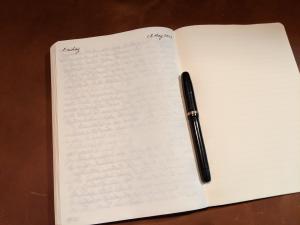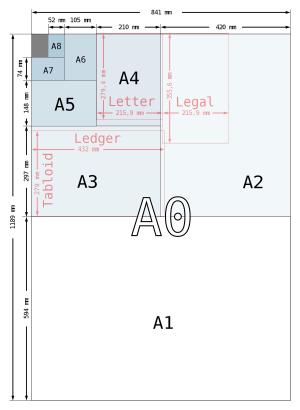Journal
A4 Effort
28 May 2021
 Brian Koberlein
Brian KoberleinI do a lot of writing by hand. Most of my blog posts are done at the computer, but things such as my personal journal, fiction writing, and other stuff are done with pen and paper. Hand writing is the way it’s been done for most of human history. When you write by hand, you are connected in many ways to that old tradition. One of the most trivial connections is the size of paper you use.
Here in the United States, the most common paper size is 8½ by 11 inches. The size is derived from a paper size dating back to the 1400s known as Foolscap Folio, or simply Foolscap. It was traditionally 8½ by 13½ and often had a watermark of a jester’s cap and bells, hence the name. For centuries foolscap was the standard size in both the U.S. and the British Empire.
But if you buy a bound notebook for writing, the most common portable size is about 5⅚ by 8¼ inches, It’s roughly the size of a folded U.S. sheet of paper, but isn’t derived from foolscap. Instead, it’s part of the A-series paper sizes, known as A5.
 Wikipedia
WikipediaThe A-series was standardized in 1922, based on the idea of physicist Georg Christoph Lichtenberg. He proposed that paper sizes have an aspect ratio of the square root of 2. Thus, with a short side of length 1, you have a long side of length 1.41421. If you fold such a sheet of paper, you get two smaller sheets of the same ratio. Fold again, the same ratio. The A-series is based on A0, with a dimension of 841 by 1189 mm. It has the Lichtenberg aspect ratio, with a total area of one square meter. The other A sizes are derived by halving. Fold A0 to get A1, again to get A2, etc. In principle, you can keep folding forever, but by A10 you’re down to the size of a postage stamp, so that’s typically the limit.
One advantage of A-series is that images scale easily. If you want to print two A5 pages on a single sheet, just print it on A4. You don’t need to adjust dimensions, because it naturally fits. If you want to print an A3 poster on A6 paper, just shrink it to ⅛ its original size. A-series is so useful it’s become an international standard for most of the world outside the U.S, which is why so many bound notebooks are A5.
The most common A-series size is A4, which is similar to the standard American paper. But, at 8¼ by about 11½ it’s just different enough to be annoying. It’s just slightly too long for a standard hanging folder, and you have to scale down A4 pages to print them on U.S. paper. And because it’s an international standard, most good quality paper is in A-series rather than U.S.
So why hasn’t America adopted A-series? That might seem like a silly question for a country that still avoids the metric system, but in this case, the answer is a bit more subtle. Papermaking is has a long tradition in the States, and much of the old equipment is still reliable. In the 1900s, Europe lost much of its paper infrastructure during the world wars, so there was some motivation to adopt a better standard when rebuilding. Since the U.S. didn’t lose infrastructure, there wasn’t the same motivation. Retooling papermaking to adopt A-series isn’t cost-effective, and the difference isn’t significant enough to change. So until America decides to make an A4 effort, we’ll be the last major holdout in the world of paper sizes.